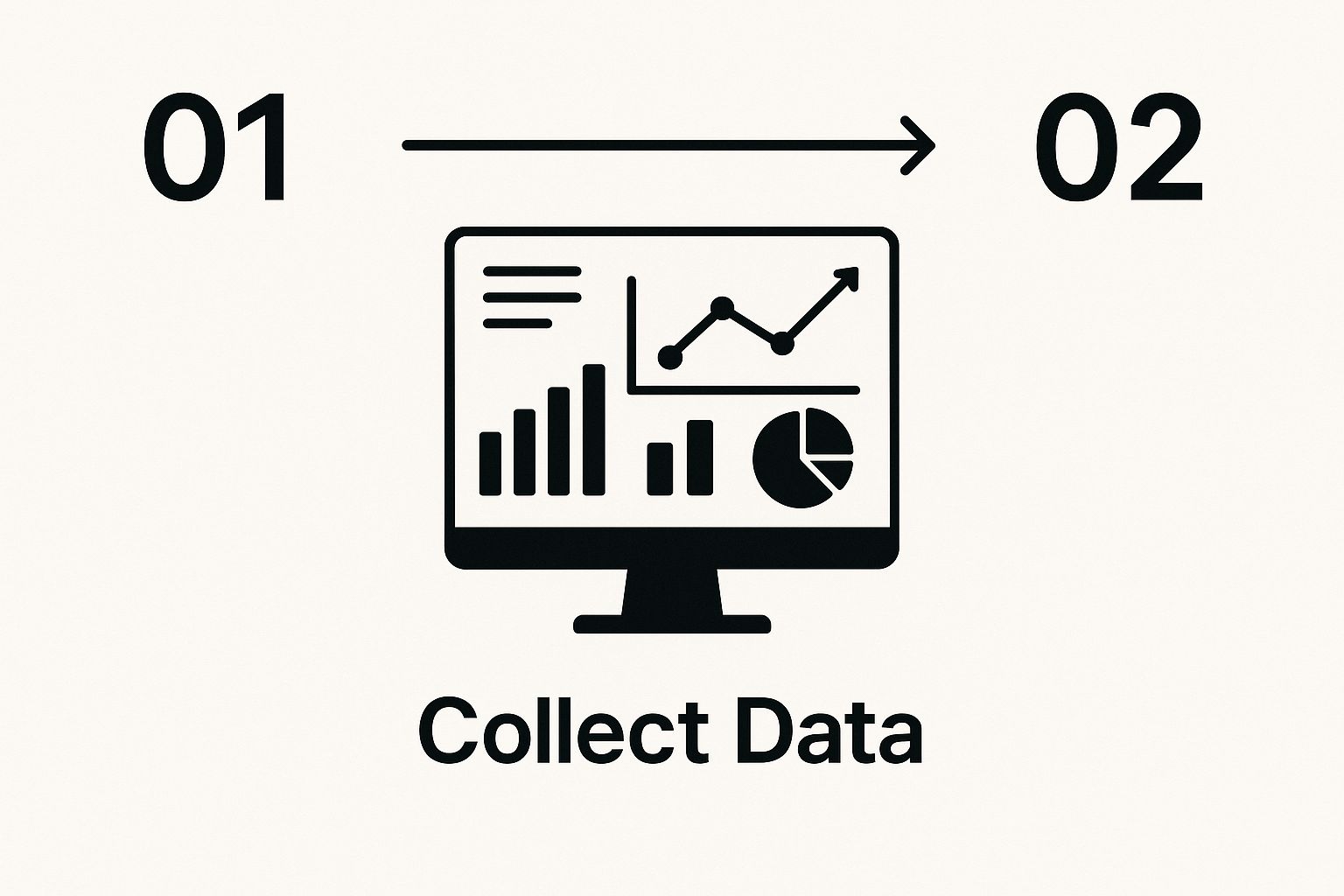
How to Measure Marketing Effectiveness: Expert Tips
Published on 2025-09-21
Knowing if your marketing is actually working comes down to one thing: tracking the right numbers to see how your strategies are hitting your business goals. This means you need to set clear objectives, pick the right key performance indicators (KPIs), gather the data, and then analyze it all to prove your return on investment (ROI) and make smarter moves next time.
Why Blind Marketing Spend Is a Thing of the Past

Gone are the days of just throwing money at campaigns and hoping for the best. In today's market, every single dollar has to pull its weight. The pressure is on to show exactly how marketing efforts translate into real business results, moving way beyond vanity metrics like a few extra likes or shares.
Measuring your marketing isn't about building overwhelming spreadsheets to impress your boss. It’s about getting real clarity. It's how you figure out what's resonating with your audience, what's falling flat, and where your best opportunities are hiding. When you get this right, marketing stops being a cost center and becomes a reliable engine for growth.
From Guesswork to Growth
The biggest hurdle most marketers face is tying specific campaigns and actions to the bottom line. If you don't have a solid way to measure this, you're basically just guessing which channels are actually bringing in customers and which are just eating up your budget.
Procter & Gamble learned this lesson the hard way. After a deep dive into their digital ad spend, they found a staggering $200 million was being completely wasted on ads that were either ineffective or showing up in the wrong places. By slashing that spend and putting the money into channels they knew worked, P&G massively improved its reach and overall marketing impact.
The goal is simple: make smarter, faster decisions backed by real data. This guide will provide a clear roadmap to do just that, outlining a process to define success, track meaningful metrics, and turn insights into your next winning campaign.
Here’s what that process looks like:
- Define What Success Means: First, you have to set clear, measurable goals that actually line up with the company's bigger objectives.
- Pick Your Metrics: Next, select the KPIs that will give you a true read on your progress toward those goals.
- Analyze the Data: This is where you turn raw numbers into actionable insights about what’s really happening.
- Optimize Your Campaigns: Finally, use those insights to tweak, refine, and improve everything you do moving forward.
For a deeper look into the entire process, check out this guide on how to measure marketing effectiveness and maximize ROI.
Setting Goals That Actually Drive Business Growth
Before you can measure anything, you have to know what you’re aiming for. Too often, marketing teams are stuck with fuzzy goals like "boost brand awareness" or "get more traffic." Those sound nice, but they're impossible to measure and don't give your team a clear target.
Real success starts when you tie your marketing efforts to tangible business outcomes.
Think about it this way: telling your team to "increase traffic" is like telling a ship's captain to just "sail east." Where are they going? How will they know when they get there? A much better instruction is, "Increase marketing qualified leads (MQLs) from organic search by 20% within the next quarter."
Now that's a goal. It's specific, measurable, and has a deadline. Your team knows exactly what success looks like.
From Vague Ideas to Specific KPIs
Once you’ve set a clear goal, the next step is to pick the right Key Performance Indicators (KPIs) to track your progress. KPIs are the specific numbers that tell you how you're doing. If you track the wrong ones, you can get a completely misleading picture.
For example, you might be celebrating a huge spike in website visitors but totally miss the fact that none of them are actually buying anything.
If your main goal is to acquire new customers, you shouldn't be obsessed with social media likes. Instead, you'd want to focus on metrics that directly impact the bottom line, such as:
- Customer Acquisition Cost (CAC): How much does it really cost you to land one new paying customer?
- Conversion Rate: What percentage of people who visit your landing page actually fill out the form or make a purchase?
- Lead-to-Customer Rate: Of all the leads you generate, what percentage actually become customers?
These metrics connect the dots between your marketing spend and actual revenue, giving you a true sense of what’s working and what isn't.
Don't just track the final sale. Paying attention to the metrics along the way is just as important. It shows you where people are dropping off in your funnel, so you can fix the leaks before they sink your campaign.
Connecting Goals to Measurement
Different goals naturally require different KPIs. A campaign aimed at keeping existing customers happy will be measured very differently from one designed to bring in new leads. It’s all about matching your metrics to the specific stage of the customer journey you’re focused on.
This alignment makes sure that every piece of data you collect has a purpose. It helps you build a clear, compelling story about how marketing is directly contributing to the company's growth.
Here’s a practical look at how to pair common marketing goals with the right KPIs.
Matching Marketing Goals to Key Performance Indicators
This table provides clear examples of how to connect common marketing objectives with the specific, measurable KPIs you should be tracking.
| Marketing Goal | Primary KPIs to Track | Example Metric |
|---|---|---|
| Increase Brand Awareness | Website Traffic, Social Media Reach, Brand Mentions, Share of Voice | A 15% increase in direct website traffic over six months. |
| Generate More Leads | Leads Generated (Total), MQLs, SQLs, Cost Per Lead (CPL) | Generate 500 new MQLs from the webinar campaign in Q3. |
| Improve Customer Acquisition | Customer Acquisition Cost (CAC), Conversion Rate, Lead-to-Customer Rate | Decrease CAC by 10% by optimizing ad spend in the next quarter. |
| Enhance Customer Retention | Customer Churn Rate, Customer Lifetime Value (CLV), Repeat Purchase Rate | Increase the repeat purchase rate for first-time customers by 5% this year. |
| Boost Engagement | Email Open/Click-Through Rate, Social Media Engagement, Time on Page | Achieve an average email click-through rate of 4% for the new nurture sequence. |
By aligning your goals and KPIs this way, you move from simply being busy to being effective. You'll know exactly what to measure and why it matters to the business.
Picking the Right Measurement Framework and Tools
Alright, you’ve got your goals defined. Now comes the tricky part: actually tracking your progress. This means choosing a measurement framework—the "how"—and then picking the right tools for the job. Honestly, this is where a lot of marketers stumble, often falling back on overly simple models that don't paint the full picture.
The most common starting point is last-click attribution. It’s straightforward: this model gives 100% of the credit for a sale to whatever a customer clicked on last. While it’s easy to track and understand, it’s a deeply flawed way to see the world. It completely ignores all the other marketing touchpoints that nudged that customer along their journey.
Think of your digital dashboard as your command center. It's where all these different data points come together to show you what's really happening.

Mapping out how your data flows, from the moment you collect it to when you analyze it, is the first real step toward building a system that turns raw numbers into smart decisions.
Moving Beyond the Last Click
To get a more honest look at what’s working, smart marketers use multi-touch attribution models. These frameworks spread the credit across several interactions, giving you a much more balanced view of which channels are pulling their weight.
There are a few popular models to consider:
- Linear: Simple and fair. Every touchpoint gets an equal slice of the credit. The downside is that it assumes every interaction is equally important, which is rarely true.
- Time-Decay: This one gives more credit to the touchpoints closest to the conversion. It’s a great fit if you have a short sales cycle where the most recent interactions are the most influential.
- Position-Based (U-Shaped): My personal favorite for many scenarios. It gives 40% of the credit to the very first touchpoint and 40% to the last one, then splits the remaining 20% among everything in the middle. It values both what got the customer in the door and what closed the deal.
The right model really depends on your business. A B2B company with a six-month sales cycle will get much more value from a time-decay or position-based model. But if you're a simple e-commerce shop, last-click might be good enough to start with. Don't overcomplicate it if you don't have to.
The Return to a More Holistic View
Let's be real—privacy updates from companies like Apple have thrown a wrench in our ability to track individual users. This has sparked a huge comeback for an old-school, big-picture method: Marketing Mix Modeling (MMM). Instead of following people around with cookies, MMM uses statistical analysis to see how different marketing activities impact overall sales.
This is a big shift. A 2024 study involving both academics and industry pros confirmed that combining MMM with controlled experiments is the most reliable way to get insights in today’s privacy-focused environment.
MMM helps you answer the big questions, like, "For every dollar we pump into TV ads, how much revenue are we actually getting back?" It’s a powerful way to see the true impact of a channel without needing to track every single click.
Assembling Your Measurement Tech Stack
You don't need to spend a fortune to build a capable tech stack. For most businesses, a few core tools will get you most of the way there.
- Web Analytics: This is non-negotiable. A tool like Google Analytics 4 (GA4) is your foundation. It's how you track website traffic, see what users are doing, and measure conversions.
- Customer Relationship Management (CRM): Your CRM, whether it's HubSpot or Salesforce, is where your actual customer data lives. When you connect it to your analytics, you can finally tie your marketing campaigns directly to sales revenue.
- Data Visualization: Raw data is messy. Tools like Looker Studio (formerly Google Data Studio) or Tableau help you build dashboards that turn your numbers into a clear story. This is absolutely essential if you want to master content performance analysis and get buy-in from your team or clients.
The Core Metrics to Track Across Your Key Channels
Now that you have your framework sketched out, it's time to get specific. Measuring marketing effectiveness isn't about chasing every number you can find; it’s about locking in on the key performance indicators (KPIs) that actually point to revenue and growth. Let's cut through the noise and focus on what truly moves the needle.
For instance, a high-level dashboard in Google Analytics can show you where your traffic is coming from.
Seeing your total user count is one thing, but the real insight comes from understanding which channels—like organic search or paid ads—are delivering the most valuable, engaged visitors.
SEO Performance Metrics
Success in SEO is so much more than just hitting the #1 spot for a keyword. The real win is attracting visitors who are actively looking for what you offer and are ready to take the next step.
- Organic Conversion Rate: This is the big one. It tells you exactly what percentage of people who find you through a search engine actually complete a goal, whether that’s buying a product or filling out a contact form.
- Keyword Rankings for High-Intent Terms: Stop obsessing over every keyword. Concentrate on the ones that signal someone is ready to buy. Think "emergency plumber near me" versus the much broader "how to fix a leaky faucet." One is a problem, the other is a cry for help.
- Share of Voice (SOV): How visible are you compared to your competitors? SOV gives you a solid estimate of your market presence for the keywords that matter most, showing you where you stand in the competitive landscape.
Paid Advertising Metrics
When you're running paid campaigns on platforms like Google Ads or Meta, you have to watch your budget like a hawk. The goal isn't just to spend money—it's to make more than you spend.
The most critical metrics for paid ads are the ones tied directly to your bottom line. If your Return on Ad Spend (ROAS) is less than 1, you're losing money on every sale, no matter how cheap your clicks are.
These are the numbers that count:
- Return on Ad Spend (ROAS): This is the ultimate gut check for e-commerce. For every dollar you put into ads, how many dollars do you get back in revenue?
- Customer Acquisition Cost (CAC): What does it cost, on average, to bring in a new customer through your paid efforts? This number is only useful when you weigh it against your Customer Lifetime Value (CLV) to make sure you're building a profitable business.
- Click-Through Rate (CTR): While CTR doesn't directly measure profit, it's a vital health indicator. A high CTR means your ad creative and copy are hitting the mark with your audience, which is a fantastic leading sign of a successful campaign.
Social Media and Content Marketing
Social media can feel a bit fuzzy to measure because it often plays a role at the top of the funnel (awareness) and the bottom (conversion). It's crucial to look beyond likes and shares. Those metrics are nice for the ego, but they don't keep the lights on.
Instead, you have to connect your social and content efforts to real business results. Our guide on how to measure social media ROI digs into exactly how to do this.
Try focusing on these instead:
- Assisted Conversions: How often did a blog post or a social media update show up as a touchpoint in a customer's journey before they finally converted? This tells you the supporting role your content plays.
- Lead Generation: Count the number of new leads you get directly from your content—think gated e-books, webinar sign-ups, or newsletter subscriptions embedded in your blog posts.
By keeping a close eye on these channel-specific KPIs, you’ll get a much clearer, more actionable picture of what’s working. This is how you start making confident decisions about where to invest your time and money.
Turning Your Data Into Actionable Insights

Let's be honest, collecting data is the easy part. The real work—and where the magic happens—is turning all those raw numbers into smart decisions that actually move the needle for your business. A report full of metrics is just a piece of paper until you learn to read between the lines and figure out the "why" behind the "what."
Think of it less like crunching numbers and more like being a detective. Your data is telling a story about what’s working, what's falling flat, and where your next big opportunity might be hiding. The goal is to stop just reporting on what happened and start actively shaping what happens next.
Finding the Story in Your Numbers
To get started, you have to look past the obvious metrics. Sure, a big spike in website traffic looks great on a chart, but what does it really mean? Did those new visitors stick around and convert, or did they hit the back button in a few seconds? Digging into these deeper questions is how you start to understand what's truly effective.
Here are a couple of powerful ways to uncover those insights:
- Audience Segmentation: Don't treat your entire audience as one big monolith. Group them by their behavior, where they came from, or who they are. You might find that customers from organic search have a 30% higher lifetime value than those you acquired through paid social ads. Now that's an insight you can act on.
- A/B Testing: Stop guessing which headline or call-to-action is better—test it! Running simple, controlled experiments lets you make small, data-driven tweaks that can lead to massive improvements in your conversion rates over time.
The heart of data analysis isn't just spotting trends; it's understanding the human behavior that creates them. Every click, every view, every purchase is a choice. Your job is to figure out why they made it.
Practical Analysis Techniques
Cohort analysis is another go-to technique, especially for understanding long-term customer value. This is where you group users based on when they first signed up or made a purchase, then watch how they behave over months or even years. It’s a goldmine for insights into retention and churn.
For example, a cohort analysis might reveal that customers who signed up during a holiday sale are 50% more likely to churn after just three months. That’s a game-changing piece of information. It tells you that your big promotion attracted the wrong kind of customer, giving you a clear direction on how to fix your strategy for next year.
If you really want to get into the weeds of collecting and dissecting marketing data, this guide on mastering B2B marketing analytics is an excellent resource.
By blending these different methods, you start to build a much clearer picture of your marketing performance. The insights you pull from your https://autoghostwriter.com/blog/content-performance-metrics become your roadmap, turning raw data into a set of clear, confident next steps. It's a proactive approach that ensures your marketing is always getting smarter, guided by what your audience is telling you through their actions.
Where Marketing Measurement Is Headed Next
The world of marketing analytics is always in motion, but right now, we're in the middle of a pretty significant shake-up. If you want to stay ahead, you have to stop just reporting on what happened last month and start looking at what's coming. The future of measuring marketing is less about the rearview mirror and more about what’s around the next bend.
This whole shift is being supercharged by AI and machine learning. These aren't just buzzwords anymore; they’re fundamentally changing how we measure success. Instead of simply analyzing last quarter's numbers, you can now get a real sense of future trends, predict what your customers will want, and even get your budget right before you launch. It’s about moving from reaction to prediction.
Tying It All Together with Unified Frameworks
Let's be honest: data silos are a nightmare. You’ve got data in your CRM, more in your ad platforms, and a whole different story in your web analytics. Trying to stitch together a complete picture of the customer journey from all those pieces is a huge challenge. That’s exactly why unified measurement frameworks are becoming so critical.
Think of these frameworks as the central hub for all your data. They pull everything together from all those different sources to give you a single, reliable view of what’s going on. Suddenly, you can see how all the channels work together and get a much clearer picture of what's actually making an impact.
The goal here is to stop juggling a bunch of separate reports and start building a single, cohesive intelligence system. It's the only way to truly map those messy customer journeys and see how one touchpoint influences the next.
Measuring What Your Customers Actually Care About
The metrics we track have to evolve right along with consumer values. The smartest brands are catching on that profit isn't the only thing that matters anymore. If you're taking a purpose-driven approach to your marketing, you need a wider set of KPIs that show your company's impact on the world.
This is leading to a whole new standard for measuring marketing effectiveness. We’re starting to see metrics that track things like sustainability and social impact. For instance, brands are now tracking their carbon footprint reduction and their Social Return on Investment (SROI). If you want to dig deeper, you can explore more on these marketing effectiveness trends and see how they’re shaping future strategies.
This isn’t just about feeling good—it’s smart business. Today’s consumers often choose brands that align with their own values. By tracking these purpose-driven metrics, you're not just checking a box; you're ensuring your marketing connects with people on a much deeper level.
Got Questions? We’ve Got Answers.
Even the best-laid plans can hit a few snags. When it comes to measuring your marketing, a few questions pop up time and time again. Let's tackle them head-on.
I’m on a Tight Budget. Where Do I Even Start?
This is a common one, and the answer is simpler than you think. Don't worry about expensive, complex software right out of the gate. Your best friends are the powerful, free tools you probably already have access to.
Start with Google Analytics. It's the gold standard for a reason and gives you a mountain of data on your website traffic and user behavior. Pair that with the built-in analytics on your social media platforms—every major channel from Meta to LinkedIn has its own dashboard.
The key here is focus. Instead of getting overwhelmed by tracking dozens of metrics, pick one or two that truly matter to your bottom line. Is it the conversion rate on your most important product page? Or maybe the number of qualified leads coming from your blog? Zero in on what drives real business results.
How Often Should I Actually Check My Marketing Metrics?
There’s no magic number here. The right cadence really depends on what you're looking at and why. Trying to track everything daily will just drive you crazy.
Here’s a practical breakdown I’ve seen work for countless teams:
Daily or Weekly Checks: This is for your fast-moving, tactical metrics. Think click-through rates (CTR) on a new ad campaign or the engagement on a social media post you just launched. These numbers give you immediate feedback to make small, quick adjustments.
Monthly or Quarterly Reviews: Save this rhythm for your big-picture metrics. This is when you step back to analyze things like your overall Customer Acquisition Cost (CAC) and the ROI from different channels. Looking at this data over a longer period helps you spot real trends, not just daily noise, so you can make smarter strategic decisions.
The goal is to find a sustainable rhythm. Checking certain numbers too often can cause you to overreact to normal fluctuations. But waiting too long means you could miss a huge opportunity or a critical problem.
If You Had to Pick One, What’s the Most Important Metric to Track?
If I had to choose just one, it wouldn't be a single metric, but a single ratio: Customer Lifetime Value (CLV) to Customer Acquisition Cost (CAC).
This one calculation tells you so much. It answers the fundamental question: "Are we spending money to acquire customers who will ultimately make us profitable?"
A single campaign can have a great conversion rate, but if you're paying $300 to acquire customers who only ever spend $150, you have a leaky bucket. The CLV:CAC ratio moves the conversation beyond vanity metrics and gets right to the heart of sustainable growth. It's the ultimate health check for your marketing engine.